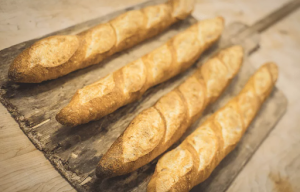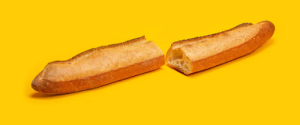French Baguette Bread Types and Fun Facts!
French baguette is emblematic of French culture. Ask anyone what comes to mind when you mention that country, and they will most likely describe a beret and striped shirt-wearing mustachioed fellow with a baguette tucked under his arm. Remove the baguette bread, and the portrait would be incomplete, just like a musketeer without his sword, or a jouster without his lance.
But what makes a perfect baguette? And how was this shape of bread invented in the first place? Join Dessert Advisor to find out all of this, as well as fun facts and other types of baguettes, and how to reduce world hunger.
Traditional French-style baguette on a poolish base (Boulangerie Guillaume)
What makes a perfect French baguette bread
First and foremost, what exactly is a baguette? The word means “stick” in French, which hints us about its shape: long and thin. A properly-made baguette must have a very flaky and crunchy outside (which can sometimes give your jaw a workout) and a soft doughy interior. It’s great for eating as a spread with butter, jam or foie gras, and as an accompaniment to cheese, fruits and cold cuts, or even, if it’s a really good one, on its own. Who can resist ripping a piece off and eating it on the way back home from the bakery?
It’s usually made with four simple ingredients: wheat flour, water, yeast, and common salt. The yeast type can vary. Some use common baker’s yeast, while others, typically the artisanal kind, call for a pre-ferment (poolish) to increase flavour complexity and other characteristics.
Baguette types
Now that we know what defines a baguette and how it’s made, let’s take a look at the different baguette types:
- The classique, which varies in quality. It can be mass-produced and baked with additives, making it the cheaper alternative.
- The baguette tradition is usually bigger, crispier and tastier. Many strict rules apply to the tradi: it must be made on-site where it is sold (therefore not with frozen dough delivered from elsewhere, like the classique) using only flour, salt, yeast and water (additives aren’t allowed) and it must be allowed to prove twice (in other words, to rest and rise outside of the oven). This artisanal baguette was introduced by the government in 1993 to address falling bread sales in France. Many French people remain committed to the classique, so to decide which you prefer, you should probably try both.
- The ficelle (string) is thinner in width while the flûte is larger.
- Shorter-length ones are sometimes called bâton or demi-baguette.
 Artisanal baguette (Les Co’pains d’abord)
Artisanal baguette (Les Co’pains d’abord)
How the French baguette came about and became France’s most popular bread?
Baguette is so widespread, not only in France but across the world, that we rarely think of how it started, and that there was once a baguette-less time.
Its exact origin is hard to pinpoint, but it is generally accepted that the first iterations of this bread came about in the eighteenth century, and acquired the name baguette around the 1920s.
But how did it become such an emblematic French bread? There is no official story, but there are different unconfirmed hypotheses:
- Shape invented for transport during the Napoleonic wars: The original round loaf shape wasn’t practical for soldiers to take with them during long campaigns. The emperor therefore decreed a change in shape, making a more transport-friendly bread.
- Inspired by the Viennese bread (similar shape, but shorter and more round) and then introduced to France in the 19th century in Paris’ Boulangerie viennoise. Then, after a law was passed in 1919 saying workers cannot start work before 4am, the baguette gained in popularity as this bread needs less time to bake than other kinds, and could therefore be prepared in time for the morning customers.
- Gained in popularity when the metro was being built in Paris: on the way between home and work, workers would typically carry loaves of bread and knives to cut them. But since fights regularly broke out among workers, authorities wanted them to avoid carrying knives in the metro, and so promoted the baguette, which can be eaten by ripping off pieces by hand, without the need for a knife.

Le Petit Parisien, Willy Ronis (1952)
Fun facts about baguettes
Every year since 1994, a Grand prix de la baguette is held in Paris to crown the best baguette baker of the country. A panel of judges consider each bread’s texture, flavour and crumbiness, and the winner becomes the official daily bread supplier of the French president for an entire year, until next year’s winner is chosen.
How many baguettes are sold per year, in France alone? 10 billion! Can you even imagine what 10 billion baguettes look like? That means more than 300 baguettes sold every second, and more than 27 million per day.
In 2022, the artisanal know-how and culture of baguette bread was inscribed to the UNESCO Intangible Cultural Heritage Lists.

Corn-crusted Raisin and Fennel Baguette (Arhoma)
World hunger
Since bread was at the center of famished peasants’ grievances during the French Revolution, it reminds us that today still, across the world, millions of people suffer from malnutrition. According to Action Against Hunger, after steadily declining for a decade, world hunger is on the rise, affecting nearly 10% of people globally. From 2019 to 2022, the number of undernourished people grew by as many as 150 million, a crisis driven largely by conflict, climate change, and the COVID pandemic.
However, according to World Vision, global hunger is not just the state of people being hungry. It does not end when you give them meals on a regular basis. Hunger is also associated with the distress that comes with the lack of food. It means not having the energy and strength to work and provide more food for the family. It’s the lack of food resources forcing people to uproot themselves from home. It’s a vicious cycle that a person cannot escape from simply by having food to eat.
Moreover, there are three different types of food insecurity:
- Marginal food insecurity: Difficulty accessing food due to income, such as anxiety about running out of food or having limited food choices.
- Moderate food insecurity: Necessary trade-offs in the quantity and/or quality of food consumed.
- Severe food insecurity: Reduction in food consumption and disruption of eating patterns.
Conflict remains the key driver of hunger around the world. The war in Ukraine has further exacerbated the hunger crises in East Africa and elsewhere because of skyrocketing food and fertilizer prices.
Luckily, solutions and initiatives are being put in place:
- Bread and Beyond operates in Montreal, Canada. Its main activity is to deliver and make fresh and nutritious sandwiches for shelters that help the homeless in Montreal. On average, 2,500 sandwiches are delivered weekly.
- Bridge Bread Bakery is a social enterprise located in the United States. Its initiative is to hire people who are homeless or in precarious housing situations. The mission of this program is to help disadvantaged people engage in financially rewarding endeavors that value them, promote their dignity and enable them to help themselves.
- Women’s Bakery is located in Denver and in Kigali, this program was established to create access to gainful employment for women and to sell nutritious and affordable breads through profitable bakeries in East Africa.
This blog definitely made us crave some fresh-baked, warm French baguette bread! And there is probably a loaf with your name on it, baking somewhere, just waiting to be savoured. To search for the best baguettes near you, Dessert Advisor is your best bet.





